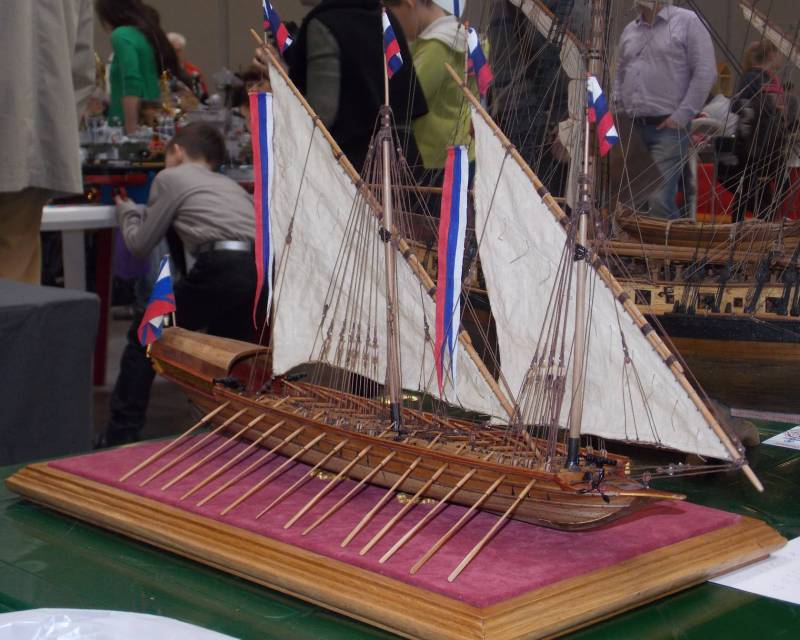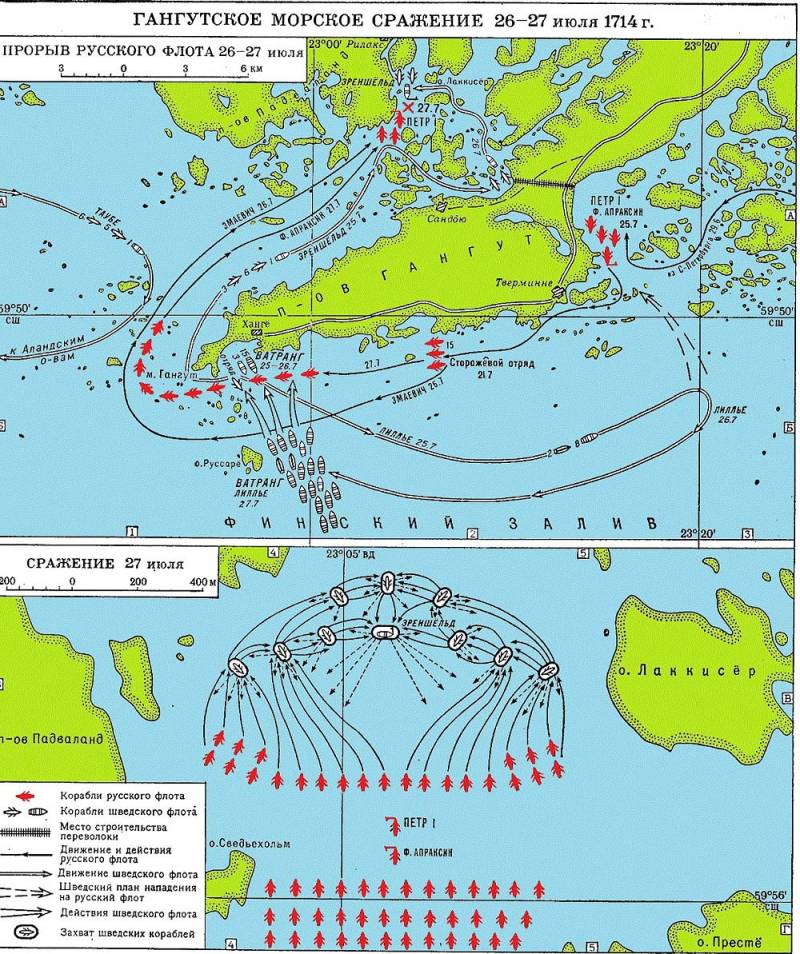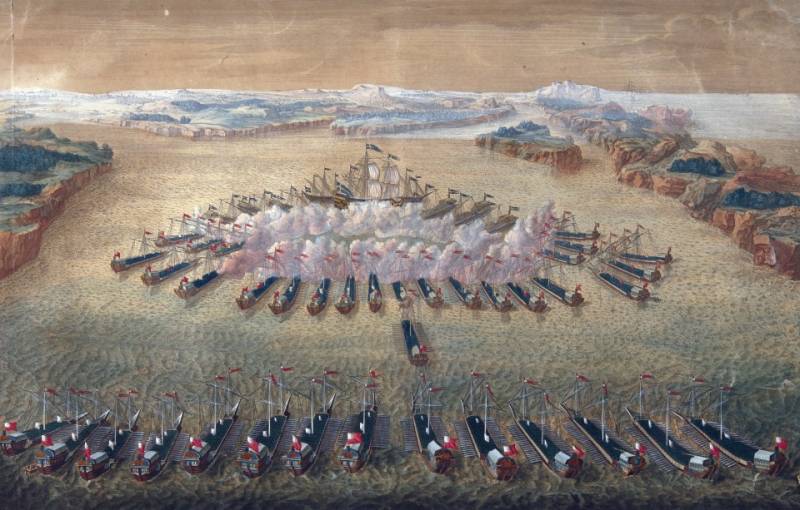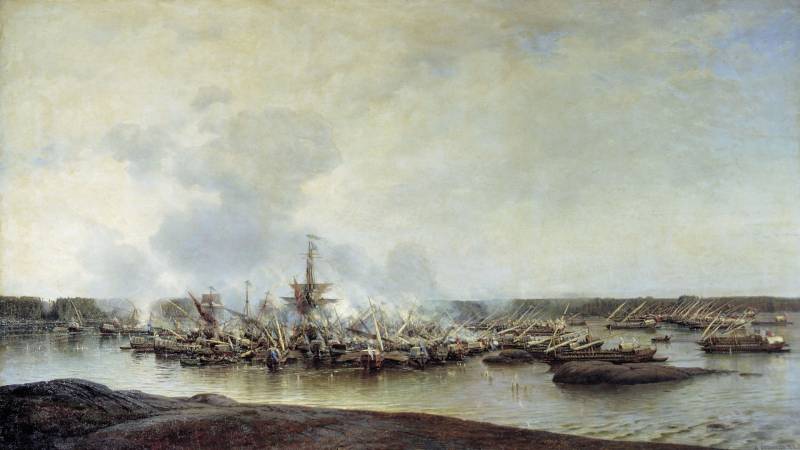Day of Military Glory of Russia: the first naval victory of the Russian fleet in the battle at Cape Gangut
This battle was a major battle of the Swedish rowing fleet, commanded by Vice Admiral Gustav Vatrang, with a rowing flotilla commanded by Fyodor Mikhailovich Apraksin. The battle took place in the Baltic Sea off the coast of the Gangut peninsula (Hanko, Finland). Victory in this sea battle forever became the first page in the book of the brilliant victories of Russian sailors and Russian weapons and was inscribed in this book with the blood of the battle participants. The Russian emperor Peter I himself, realizing the significance of this first victory of the regular Russian fleet, ordered it to be equal to the great battle of Poltava.
In 1714, the Great Northern War was already the 14 year. Hacking the famous “window to Europe” turned out to be very difficult. After the victory at Poltava, the Russian army managed to drive out the Swedes from the Baltic states during 1710-1713, and by the end of the 1714 winter, the Russian regiments were able to capture the entire south and most of central Finland. Therefore, it is time to put a fat point on the issue of Russia's access to the Baltic Sea. At the same time, over the past few years, the Swedes rightly considered the water area of the Baltic as their patrimony, feeling themselves in these waters to be the sole masters. Peter the Great did not agree with this, the ultimate military objective of which was designated as the crushing of the Swedish fleet, which seemed invincible at that time.
At the end of June 1714, the Russian rowing flotilla led by Fedor Matveyevich Apraksin was sent to the port of Abo. Today, this city and port, located in southwestern Finland at the confluence of the Aurajoki River into the Archipelago Sea (the part of the Baltic Sea between the Gulf of Bothnia and the Gulf of Finland within the Finnish territorial waters) is called Turku. The city is still officially bilingual.
The purpose of Apraksin's campaign was to deliver to Abo the 15-thousandth landing of ground forces. The landing force was to strengthen the Russian garrison of this port. As part of the Apraksin rowing fleet, Abo went to the 99 ships, including the 32 scampaway and the 67 galleys. Skampaveya is a military fleet of the Russian galley fleet of the 18th century. These ships were used for the transportation of troops, the landing of assault forces, their fire support, as well as escort and reconnaissance during actions in skerries. The length of the vessel did not exceed 30 meters, width - up to 5,5 meters. 12-18 was set in motion by the pair of oars, in addition to this, there were one or two masts with oblique sails on board. Armament could consist of 1-2 small-caliber guns, usually installed in the bow of the ship. On board, a scamp could take up 150 soldiers for a boarding battle.
In the northwestern part of the Gangut peninsula, the path of the Russian flotilla was blocked by the Swedish sailing and rowing fleet, headed by Gustav Vatrang. Under the command of Watranga there were 15 battleships, 2 bombarding galliot, 3 frigate and 9 large galleys. Anticipating the deplorable outcome of the battle with the Swedish squadron, Fyodor Apraksin decided to retreat, covering the ships behind the islands in Tverminskaya Bay. For about a month, unable to move, the Apraksin flotilla locked in Tverminn.
Hurrying to help his fleet, 20 July, Peter I personally arrived from Revel, who was hiding from his enemies under the guise of Shautbenacht Peter Mikhailov. It was Peter who initiated the daring plan for the future battle with the Swedish fleet. Noting the geographical features of the peninsula, he decided to build the so-called perevoloku. For rolling galleys and scamps on land in the shallow water of the Rylaks Fjord, a special log floor was created with a length of about two kilometers. This ingenious ploy allowed the Russian fleet to slip away from under the nose of the Swedish sailors. The Russian plan was so unexpected and impudent that Vice-Admiral Vatrang was at first confused. He decided to divide his fleet into two parts, sending to the skiers of the Rylaks Fjord a flotilla of rowing ships, commanded by Rear Admiral Erensheld. The squad included 6 large galleries, 3 Scherbot and sailing and rowing frigate Elephant. And to the place of the Russian flotilla in Tverminn, Watrang sent a detachment of Vice-Admiral Lilje, consisting of 8 battleships and two bombardier Galiots.
According to the plan of the Swedish commander, his ships were to destroy Apraksin’s flotilla during transportation by land. However, the Swedish sailors were in no hurry, so the Russian ships managed to leave the Bay of Tverminna. Using the mistake and favorable weather conditions made by Vatrang (the sea was calm, and the sailing ships of the Swedish fleet lost their mobility), 26 July 1714 of the old style Russian ships, having rounded the peninsula on the oars, managed to break through the skiers of the Rilaks fjord. At this point, one of the galleys stranded and was lost along with the crew. Despite this, part of the Swedish ships managed to be cut off in the Rylaks Fjord, separating them from the main battle group.
The fight struck the next morning. 27 July 23 Russian Scamps, personally commanded by Peter I and Lieutenant-General A. A. Weide, moved towards the Swedish squad. Even before the battle began, an envoy — Adjutant General P. I. Yaguzhinsky — was sent to the flagship of the Swedish Elephant detachment. However, the Swedes refused to lay down their arms, the battle could not be avoided. The battle itself lasted about three hours and ended with the victory of Russian weapons. In the course of a fierce boarding battle, Russian sailors managed to capture all the ships of Rear Admiral Erensheld, who, once wounded by 7, was captured.
During the battle, the Swedes lost the 361 seaman killed, the 350 man was injured, another 580 was captured. The Russian fleet lost 127 sailors killed, 341 wounded, 186 more sailors were captured, they were on board the galleys, which ran aground when breaking through the skerries. As a result of the battle, all 10 vessels of the Erensheld detachment were captured, including the flagship Elephant, which became the main Russian trophy. The rest of the Swedish fleet went to the Aland Islands. For this battle, Peter I, who personally participated in the boarding fight, showing the Russian sailors an example of courage and heroism, was promoted to vice-admiral.
The victory won by the Russian fleet near the Gangut Peninsula became the first victory of the Russian regular fleet at sea, ensuring Russia's freedom of action in the Gulf of Finland and Bothn, as well as the effective support of the Russian troops operating in Finland. During this battle, the Russian fleet command was able to use the advantages of rowing ships in the fight against the Swedish Swedish sailing fleet, managed to unravel the enemy’s maneuver and impose its own battle tactics on it, competently reacting to changes in the situation and weather conditions. In this case, the Gangut battle was one of the last major sea battles in world history, the victory in which was achieved thanks to the boarding battle.
The first celebrations of this naval victory took place in St. Petersburg as early as September 1714. The winners marched under the triumphal arch, which showed an eagle sitting on the back of an elephant (an allusion to the name of the captured Swedish frigate "Elephant"). Here was the inscription: "The Russian Eagle does not catch flies." The Elephant himself never again took part in the hostilities, he, along with other trophies of the Russian fleet, stood in the Strait of Kronverk, which skirted the Rabbit Island (between the modern building of the Admiralty and the Peter and Paul Fortress). In 1719, the king gave the order to repair the ship, in 1724, to pull it ashore at Kronverkskaya harbor and to keep it forever as a battle trophy. However, by 1737, the ship had simply rotted, and it was decided to disassemble it for firewood.
In 1735-1739, the St. Panteleimon Church was built in St. Petersburg, which was also a monument to the heroes of the Grengam battle that took place already in 1720, but on the same day - July 27, the day of memory of St. Panteleimon. After 200 years, in honor of the anniversary of this glorious naval victory on the initiative of the Imperial Russian Military Historical Society, the facade of the church was decorated with marble memorial slabs, on which grateful descendants immortalized the names of all participants in the battles of Cape Gangut and Grengam Island.
In addition, the battle is reflected in Russian art. Bogolyubov's Battle of Gangut 27 July 1714 of the Year was dedicated to the Gangut battle, Zubov's Gangut Battle of 27 July 1714 of the year, Yakhin's Gangut Battle and the engraving of Mauritius Baku's Gangut Battle. At the same time, a tradition has emerged in the Russian fleet to name ships in honor of the Gangut battle. The first name was Gangut, the Russian sailing ship of the line launched in the 1719 year.
The battle of the Russian rowing fleet at Cape Gangut in 1714, the Ezel naval battle of 1719, and the victory in 1720, at Grengam, finally broke the power of Sweden at sea. As a result of August 30 (September 10 on the new style) 1721, a peace treaty was signed between the countries in the city of Nishtadt. As a result of the concluded peace of Russia, the shores of the Baltic Sea were returned (Pernov, Riga, Revel, Narva, the island of Ezel and Dago, and others). Russia became part of the largest and most powerful states of Europe and, from 1721, officially began to be called the Russian Empire. At the same time, the battle at Cape Gangut was the first in a series of Russian naval victories that provided the country access to the Baltic.
Based on materials from open sources




Information